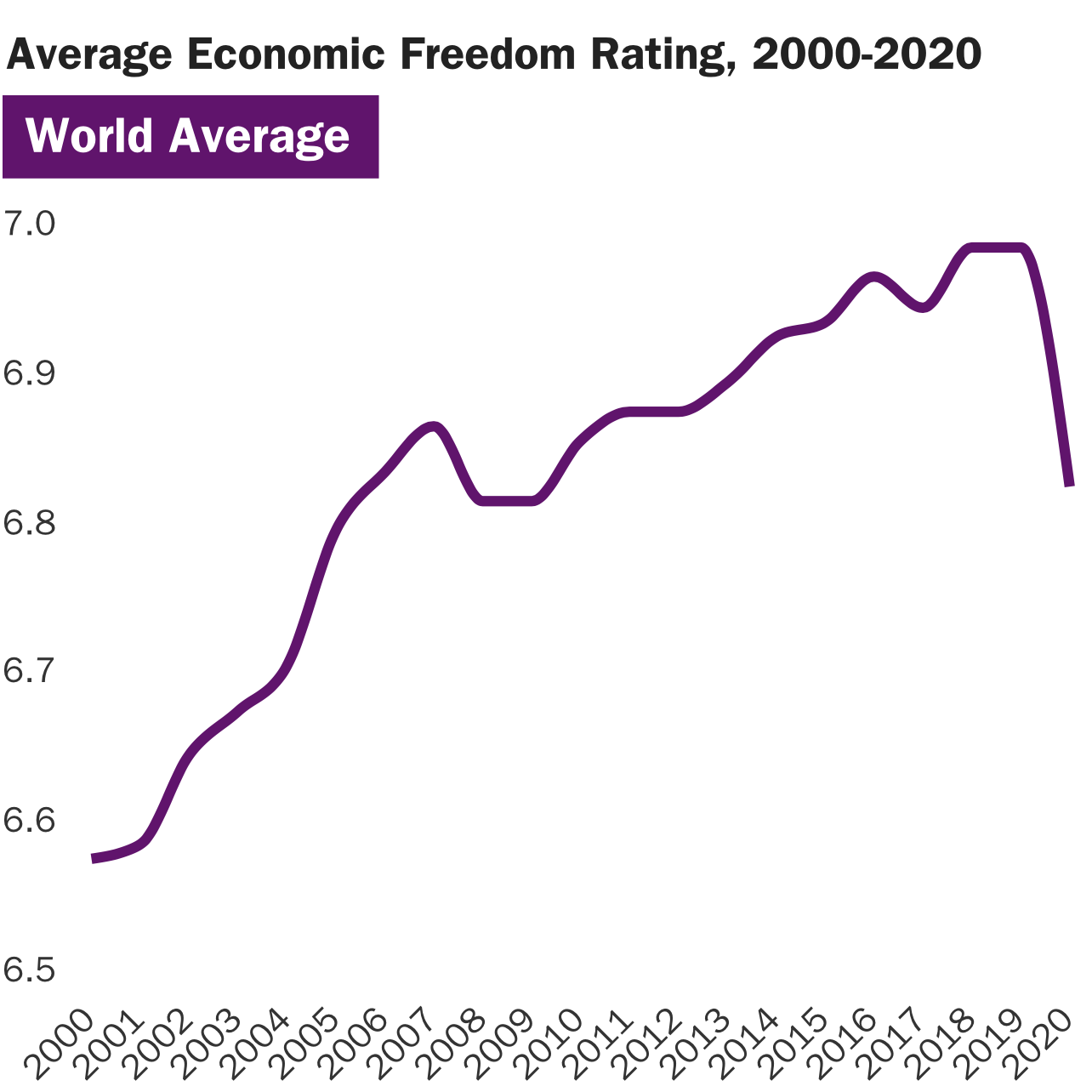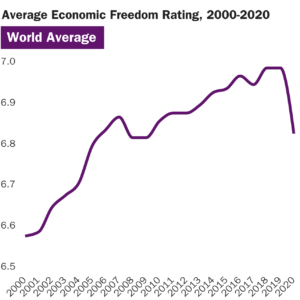

The decline has been broad‐based and dramatic. Some 146 out of 165 jurisdictions saw their scores fall from 2019 to 2020, the most recent year for which there is internationally comparable data. Some of the reasons for the decline include “massive increases in government spending, monetary expansion, travel restrictions, [and] regulatory mandates on businesses.” And although the report does not take a position on the efficacy of policy responses to the pandemic, it finds that the decline “Erases a decade’s worth of improvement in the global average and is more than three times larger than the global decline witnessed in the 2008/09 financial crisis. The coronavirus pandemic was undoubtedly a catastrophe for economic freedom.”
The U.S. rating fell as did its ranking, from 5th in 2019 to 7th in 2020.
This is from Ian Vasquez, “Global Economic Freedom Declined Sharply in Wake of Pandemic,” Cato at Liberty, September 8, 2022.
Vasquez is discussing Economic Freedom of the World: 2022 Annual Report, published annually by the Fraser Institute in Vancouver, Canada and the Cato Institute in Washington, D.C.
This project, which has been going for a few decades, is one of the most valuable data-mining projects in economics. It gives us a report card every year, with about a 1.5 year lag, on how economic freedom is faring in the majority of countries in the world.
With the strong measures most of the world’s governments took to deal with the pandemic, from huge increases in government spending, to restrictions on travel, to closing businesses, and more, it shouldn’t be surprising that economic freedom fell more in a year (2020) than in any other year since the scholars started measuring it. Of particular interest to me, given my dual citizenship (Canada/U.S.), for a number of years recently Canada was economically freer than the United States. For example, in 2013 (2015 report), Canada had a rating of 7.89 out of 10 and was ranked 9th in the world, above the United States, which was rated at 7.73 and was 16th in the world. In 2014 (2016 report), Canada moved up, getting a rating of 7.98 and ranking 5th, while the United States, with a rating of 7.75, stayed at 16th. In 2015 (2017 report), the U.S. and Canada were tied at 7.94 with a ranking of 11th. In 2016 (2018 report), United States had a rating of 8.03 with a ranking of 6th while Canada was at 7.98 with a ranking of 10th.
After that, Canada never caught up to the United States, but in 2017 (2019 report) both rose in the rating and the ranking. The U.S. rose to 8.19 with a ranking of 5th and Canada rose to 8.08 with a ranking of 8th. That was the peak ranking for both. In 2018 (2020 report), the U.S. fell to 6th although its rating rose slightly to 8.22. Canada fell to 9th, although its rating rose slightly to 8.17. They diverged even further in 2019 (2021 report), with the U.S. at 6th with a rating of 8.24 and Canada at 14th with a rating of 8.06. In 2020 (2022 report), the United States was 7th, with a rating of 7.97, while Canada was 14th with a rating of 7.81.
I’ll have more to say as I work through this year’s report and compare to past years.

READER COMMENTS
Thomas Lee Hutcheson
Sep 12 2022 at 5:48am
This kind of indexing is a good thing and worth doing. I question whether total government expenditures is a good component of such an index.
Jose Pablo
Sep 13 2022 at 1:45am
It is explained in the report:
“As government spending, taxation, and government-controlled enterprises
increase, government decision-making is substituted for individual choice and
economic freedom is reduced.”
I find the explanation very compelling.
Robert Lawson
Sep 13 2022 at 8:43am
Good summary. Because of data updates and occasional changes to the methodology, it is generally better to compare the data over the years using the most recent report. Nothing really changes greatly if you don’t do this, but using the most recent report data for all years is a better practice. Also the panel dataset is better for time series comparisons.
Comments are closed.